The Impact of Climate Change on Hydrological Regime of the Transboundary River Shu Basin (Kazakhstan–Kyrgyzstan): Forecast for 2050
Abstract
:1. Introduction
2. The Study Area
3. Materials and Methods
- Air temperature and precipitation at weather stations.
- Analysis of the temperature increase dynamics and the forecast for the period up until 2050.
- The hydrological regime and river runoff response to climate warming.
4. Results and Discussion
4.1. Regional Climate Change
4.1.1. Air Temperature
4.1.2. Precipitation
4.1.3. Analysis of Temperature Increase Rate and Forecast for 2050
4.2. Hydrological Regime and River Runoff Response to Climate Warming
4.2.1. The Current Trend in the Dynamics of Glaciation
- 42.83, 40.62 and 36.31 km2 in 1963, 1981 and 2003, respectively.
- The area of the glaciers decreased by 5.16% (with a 0.29% average annual decrease) and 10.6% (with a 0.48% average annual decrease) in 1963-1981 and 1981-2003, respectively.
- The area of glaciers decreased by 9.3% (with a 0.46% average annual reduction rate) in 1955–1979.
- The area of the glaciers decreased by 7.8% (with a 0.32% average annual reduction rate) in 1979–1999.
- The glaciers area decreased by 16.4% (with a 0.37% average annual decrease) for the entire period of 1955–1999.
4.2.2. Behavioural Reaction of Glacier- and Snow-Fed Rivers to Climate Change
4.2.3. Analysis of the River Runoff Dynamics under Conditions of Regional Climate Warming
4.2.4. Forecast of the Mean Annual Flow for the Period up until 2050
5. Conclusions
- The trend analysis of the river Shu basin WS showed a regional increase in air temperature amid global warming. The temperature rise began after 1972, and the most significant rise was recorded from 2001 to 2017. The amount of precipitation has not changed significantly, but a slight increase was recorded in the same period of 2001—2017.
- The increase in temperature has resulted in more active melting of glaciers and decreased mass and thickness. As a result, the mass balance of the glaciers of the Shu basin post-1970s is negative.
- An increase in the water availability of glacier- and snow-fed rivers was recorded post-1972 due to the more active melting of glaciers (i.e., the glacial component of runoff increased). An increase of water availability in rivers of this type will continue for the next five years, when the glacial share in the annual river runoff is to be decreased to a volume lower than previously recorded.
- The average annual discharge projection in terms of three rivers of the Shu basin, namely, Shu, Chon-Kemin, and Ala-Archa, was made based on the methodology of the retrospective analysis of runoff and the rate of water discharge increase for the observation period, as well as the further extension of data for the forecast period (until 2050).
- Considering that glacial runoff shall be reduced to a minimum by 2050, as projected by the glacier reduction forecast, the projected value was adjusted by reducing the share of glacier runoff. As a result, the mean annual discharge for the considered rivers will likely decrease by 25-30% on average by 2050.
Author Contributions
Funding
Institutional Review Board Statement
Informed Consent Statement
Data Availability Statement
Conflicts of Interest
References
- Budyko, M.I. Selected Works; Main Geophysical Observatory A.I. Voyekova; Amerit LLC: St.Petersburg, Russia, 2020; p. 206. (in Russian) [Google Scholar]
- Zhaparkulova, E.D.; Bazhanova, L.V.; Kalieva, K.E.; Nabiollina, M.S. Climate change trend at the present stage, forecast for the period up to 2050 and its impact on the water content of glacial and snow-fed rivers (on the example of the cross-border river Kurkureu-suu, Talas basin). Hydrometerol. Ecol. 2019, 198, 70–83. (In Russian) [Google Scholar]
- Baimagambetov, B.O.; Shivareva, S.P.; Ilyasov, S.A.; Agaltseva, N.A.; Safarov, M.T.; Kazakov, M.K.; Asanova, V.V.; Dzharnaeva, G.A. The Impact of Climate Change on Water Resources in Central Asia; Summary report; EDB; EC IFAS: Almaty, Kazakhstan, 2009; p. 57. (In Russian) [Google Scholar]
- IPCC. Climate Change, Synthesis Report. Contribution of Working Groups I, II and III to the Fifth Assessment Report of the Intergovernmental Panel on Climate Change; Pachauri, R.K., Meyer, L.A., Eds.; IPCC: Geneva, Switzerland, 2014; p. 163. [Google Scholar]
- Arrieta-Castro, M.; Donado-Rodríguez, A.; Acuña, G.J.; Canales, F.A.; Teegavarapu, R.S.V.; Kaźmierczak, B. Analysis of Streamflow Variability and Trends in the Meta River, Colombia. Water 2020, 12, 1451. [Google Scholar] [CrossRef]
- Ghaderpour, E.; Vujadinovic, T.; Hassan, Q.K. Application of the Least-Squares Wavelet Software in Hydrology: Athabasca River Basin. J. Hydrol.: Reg. Stud. 2021, 36, 100847. [Google Scholar]
- Azuara, J.; Sabatier, P.; Lebreton, V.; Jalali, B.; Sicre, M.; Dezileau, L.; Bassetti, M.; Frigola, J.; Combourieu-Nebout, N. Mid- to Late-Holocene Mediterranean Climate Variability: Contribution of Multi-Proxy and Multi-Sequence Comparison using Wavelet Spectral Analysis in the Northwestern Mediterranean Basin. Earth-Sci. Rev. 2020, 208, 103232. [Google Scholar] [CrossRef]
- Maharjan, M.; Aryal, A.; Talchabhadel, R.; Thapa, B.R. Impact of Climate Change on the Streamflow Modulated by Changes in Precipitation and Temperature in the North Latitude Watershed of Nepal. Hydrology 2021, 8, 117. [Google Scholar] [CrossRef]
- UN-Water. United Nations World Water Development Report 2020: Water and Climate Change; UNESCO: Paris, France, 2020. [Google Scholar]
- Dolgich, S.A.; Ilyakova, R.M.; Sabitayeva, A.U. About climate change in Kazakhstan in the past century. Hydrometerol. Ecol. 2005, 242, 6–23. (In Russian) [Google Scholar]
- Israel, Y.A.; Gruza, G.V.; Kattsov, V.M.; Meleshko, V.P. Global climate change. The role of anthropogenic impacts. Meteorology and Hydrology. 2001, 127, 5–21. (In Russian) [Google Scholar]
- GEF; UNDP. Second National Communication of the Kyrgyz Republic to the UN Framework Convention on Climate Change; Poligrafoformleniye: Bishkek, Kyrgyzstan, 2009; p. 206. [Google Scholar]
- GEF; MoERK; UNDP. Seventh National Communication and Third Biennial Report of the Republic of Kazakhstan to the UN Framework Convention on Climate Change; UNDP: Astana, Kazakhstan, 2017; p. 290. [Google Scholar]
- Mamatkanov, D.M.; Bazhanova, L.V.; Romanovskij, V.V. Water Resources of Kyrgyzstan at the Present Stage; Ilim: Bishkek, Kyrgyzstan, 2006; p. 265. (In Russian) [Google Scholar]
- Hartmann, I. Kazakhstan. Encyclopedia of Global Warming and Climate Change, 2nd ed.; Philander, S.G., Ed.; Sage Publications: Thousand Oaks, CA, USA, 2012; pp. 824–826. [Google Scholar]
- Bliss, A.; Hock, R.; Radić, V. Global response of glacier runoff to twenty-first-century climate change. J. Geophys. Res. Earth Surf. 2014, 119, 717–730. [Google Scholar] [CrossRef]
- Dikich, A.N. Problems and forecast of the development of glaciation and water content in Central Asian rivers. In Water and Sustainable Development in Central Asia; Elita: Bishkek, Kyrgyzstan, 2001; Volume 178, pp. 88–92. (In Russian) [Google Scholar]
- Dikich, A.N.; Podrezov, O.A. Climate and water supply in Kyrgyzstan. Herald KRSU 2007, 82, 20–25. (In Russian) [Google Scholar]
- Sorg, A.; Bolch, T.; Stoffel, M.; Solomina, O.; Beniston, M. Climate change impacts on glaciers and runoff in Tien Shan (Central Asia). Nat. Clim. Change. 2012, 2, 725–731. [Google Scholar] [CrossRef]
- Deng, H.; Chen, Y. Influences of recent climate change and human activities on water storage variations in Central Asia. Hydrology 2017, 544, 46–57. [Google Scholar] [CrossRef]
- Dikich, A.N. The Main features of the Conditions of Existence of the Modern Tien Shan Glaciation. In The Icing of the Tien Shan; Ilim: Frunze, Kyrgyzstan, 1976; pp. 3–14. (In Russian) [Google Scholar]
- Podrezov, O.A.; Dikich, A.N.; Bakirov, K.B. Variability of climatic conditions and glaciers of the Tien Shan over the past 100 years. Herald KRSU 2001, 86, 33–40. (In Russian) [Google Scholar]
- Li, Y. Glacier Changes and Their Linkage to the Climate-Topographic Context in the Borohoro Mountains, Tian Shan 1977–2018. Water 2020, 12, 1502. [Google Scholar] [CrossRef]
- Sorg, A.; Huss, M.; Rohrer, M.; Stoffel, M. The days of plenty might soon be over in glaciered Central Asian catchments. Environ. Res. Lett. 2014, 10, 104018. [Google Scholar] [CrossRef]
- Murtazayev, U.I.; Kaliyeva, K.E. Some issues of international cooperation of Central Asian countries in the joint use of water and energy resources (WER) on transboundary rivers. In Proceedings of the Materials of the International Scientific-Practical Conference “Modern Aspects of Using the Natural Resource Potential of Transboundary Rivers of Central Asia”, Taraz, Kazakhstan, 10–12 November 2009; pp. 74–78. (In Russian). [Google Scholar]
- Orlovsky, N.; Zonn, I.; Kostianoy, A.; Zhiltsov, S. Climate change and water resources in Central Asia. The herald of the diplomatic academy of the MFA of Russia. Russ. World. 2019, 158, 56–78. (In Russian) [Google Scholar]
- Li, V.I.; Domran, A.O.; Lineysteva, A.V. Assessment of vulnerability of water resources of Kazakhstan under anthropogenic climate change for the future until 2035. Meteorol. Hydrol. 2011, 128, 37–55. (In Russian) [Google Scholar]
- Li, V.I.; Popova, V.P. Assessment of vulnerability of water resources of Kazakhstan under anthropogenic climate change in the first half of the 21st century. Meteorol. Hydrol. 2008, 120, 27–46. (In Russian) [Google Scholar]
- Mustafayev, Z.S.; Ibatullin, S.R.; Koibagarova, K.B. Use of water resources of transboundary rivers in the conditions of modern development of water management complexes of Kazakhstan. In Balanced Use of Water Resources of Transboundary Rivers; Daik-Press: Taraz, Kazakhstan, 2005; p. 111. (In Russian) [Google Scholar]
- State Water Resources Agency under the Government of the Kyrgyz Republic. Available online: https://www.water.gov.kg/index.php?lang=en (accessed on 5 March 2021).
- Ryabtsev, A.V.; Tverdovskiy, A.I.; Botantayeva, B.S. Scheme of Integrated Use and Protection of Water Resources of the River Shu Basin with Tributaries; Book 1 Summary Note; Kazgiprovodkhoz: Almaty, Kazakhstan, 2007; Volume I, p. 180. (In Russian) [Google Scholar]
- Bazhanova, L.V. Forecast of River Water Content and Distribution of Water Resources for 2020; The Report of the UNDP-GEF KYR: Bishkek, Kazakhstan, 2002; p. 47. (In Russian) [Google Scholar]
- Agency on Hydrometeorology Under the Ministry of Emergency Situation of the Kyrgyz Republic. Available online: http://hydro.kgm.kg/index (accessed on 5 March 2021).
- Main Directorate of the Hydrometeorological Service under the Council of Ministers of the USSR. Surface Water Resources of the USSR: Basin of Issyk-Kul Lake, Shu, Talas, Tarim Rivers; Gidrometeoizdat: Leningrad, USSR, 1973; Volume 14, p. 308. (In Russian) [Google Scholar]
- Schulz, V.L. The Rivers of Central Asia; Gidrometeoizdat: Leningrad, USSR, 1965; p. 691. (In Russian) [Google Scholar]
- Kuzmichenok, V.A. Mathematical and cartographic modelling of possible changes in water resources and glaciation of Kyrgyzstan with climate change. Her. KRSU 2003, 88, 53–64. (In Russian) [Google Scholar]
- Bazhieva, A.M. Determination of the statistical characteristics of the flow of the river Shu. Hydrometerol. Ecol. 2005, 242, 100–105. (In Russian) [Google Scholar]
- Burlibayev, M.Z.; Bazhieva, A.M. Changes in the hydrological regime of the lower river Shu. In Proceedings of the Materials of the International Scientific-Practical Conference “Modern Aspects of Using the Natural Resource Potential of Transboundary Rivers of Central Asia”, Taraz, Kazakhstan, 10–12 November 2009; pp. 33–36. (In Russian). [Google Scholar]
- Madibekov, A.S.; Alimkulov, S.K.; Bazhieva, A.M. Climatic changes and their impact on the runoff of the south and south-east of Kazakhstan. In Proceedings of the 2nd International Scientific Conference “Climatology and Glaciology of Siberia”, Tomsk, Russia, 20–23 October 2015; pp. 332–334. (In Russian). [Google Scholar]
- Dostay, Z.D.; Kulebayev, K.M.; Kamaliev, A.M. Hydrological monitoring on the rivers of the Shu-Talas basin and its development. Hydrometerol. Ecol. 2018, 200, 84–91. (In Russian) [Google Scholar]
- Samarskij, A.A.; Mikhailov, A.P. Mathematical Modelling: Ideas, Methods, Examples, 2nd ed.; Fizmatlit: Moscow, Russia, 2011; p. 320. (In Russian) [Google Scholar]
- Afanasyev, A.N. Fluctuations of the Hydro Meteorological Regime on the Territory of the USSR; Science: Moscow, Russia, 1967; p. 233. (In Russian) [Google Scholar]
- WMO (World Meteorological Organization). International Glossary of Hydrology; No. 385; WMO: Geneva, Switzerland, 2012. [Google Scholar]
- Raghunath, H.M. Hydrology: Principles, Analysis, and Design; New Age International (P) Ltd.: New Delhi, India, 2006. [Google Scholar]
- Georgievsky, Y.M.; Shanochkin, S.V. Hydrological Forecasts: A Text Book; Russian State Medical University: St. Petersburg, Russia, 2007; p. 427. (In Russian) [Google Scholar]
- Musy, A.; Hingray, B.; Picouet, C. Hydrology, A Science for Engineers; CRC Press: Boca Raton, FL, USA, 2015; p. 592. [Google Scholar]
- Podrezov, O.A.; Bakirov, K.B.; Zakurdaev, A.A.; Mayastkaya, I.A. The modern climate of Kyrgyzstan and the scenario of its changes in the XXI century. Bull. KRSU 2002, 86, 33–40. (In Russian) [Google Scholar]
- GEF; UNEP. 3rd National Communication of the Kyrgyz Republic on the UNDP Framework Convention on Climate Change in Kyrgyzstan; OsOO “El Elion“: Bishkek, Kyrgyzstan, 2016; p. 264. (In Russian) [Google Scholar]
- Dibold, A. Impact of Glacial Melting with Reference to Water Resource in Central Asia; Final Report of Workshop in Almaty 11–12 April 2013, Kazakhstan; Altyn Nusga: Ashgabat, Turkmenistan, July 2013. (In Russian) [Google Scholar]
- Cherednichenko, A.V. The climate of Kazakhstan as a response to global change. Meteorol. Hydrology. 2009, 222, 7–22. (In Russian) [Google Scholar]
- Academy of Sciences of the Kyrgyz SSR. Climate of the Kirghiz SSR; Ryazantseva, Z.A., Ed.; Ilim: Frunze, Kyrgyzstan, 1965; p. 291. (In Russian) [Google Scholar]
- Medeu, A.R.; Malkovsky, I.M.; Toleubayeva, L.S.; Tairov, A.Z.; Sorokina, T.E.; Puzikov, E.M.; Dolbeshkin, M.V.; Povetkin, R.D.; Abdibekov, D.U.; Tolekova, A. Sustainable Water Supply Strategy of the Republic of Kazakhstan for the period until 2050. Quest. Geogr. Geoecology. 2018, 100, 18–46. (In Russian) [Google Scholar]
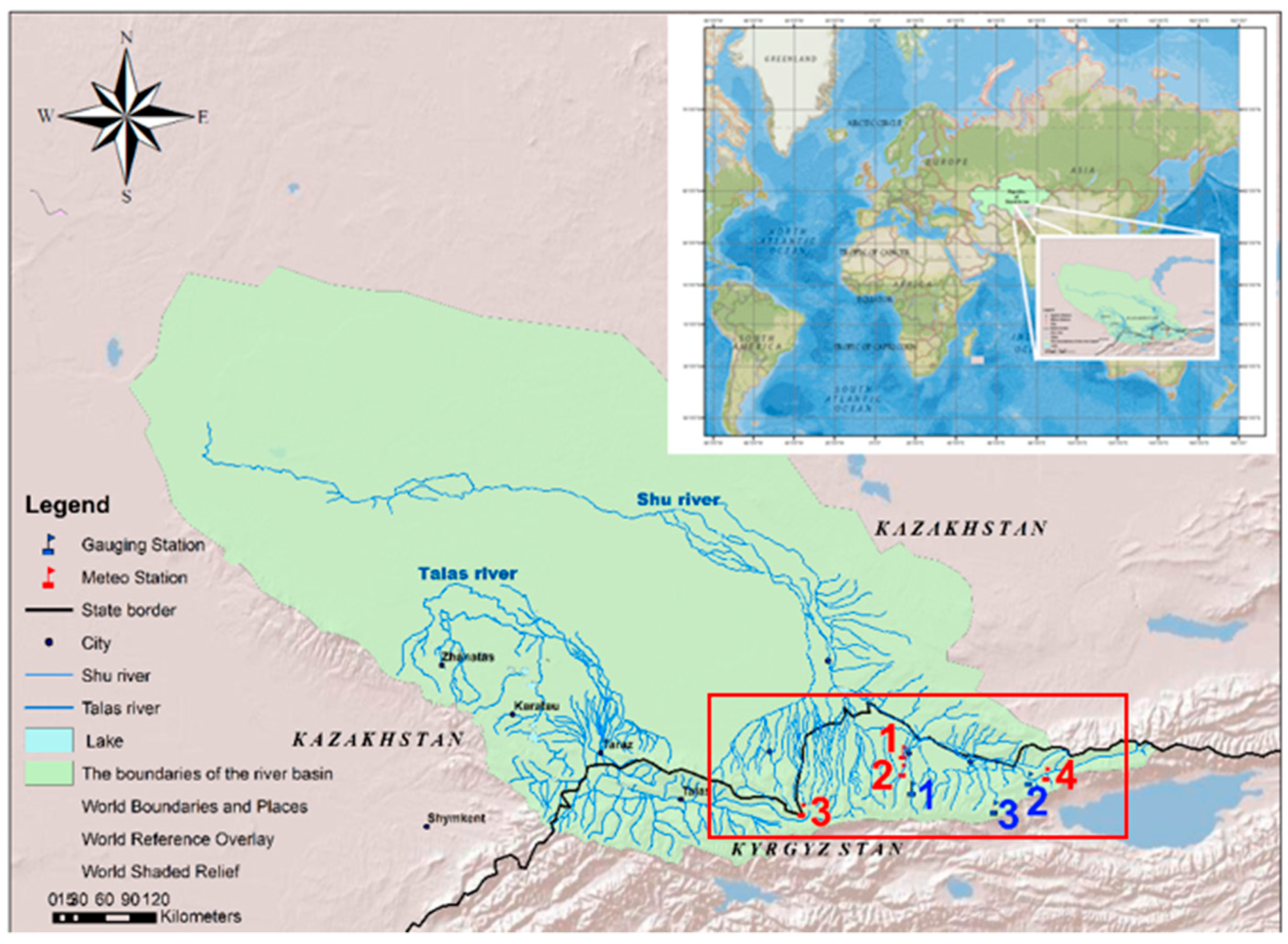
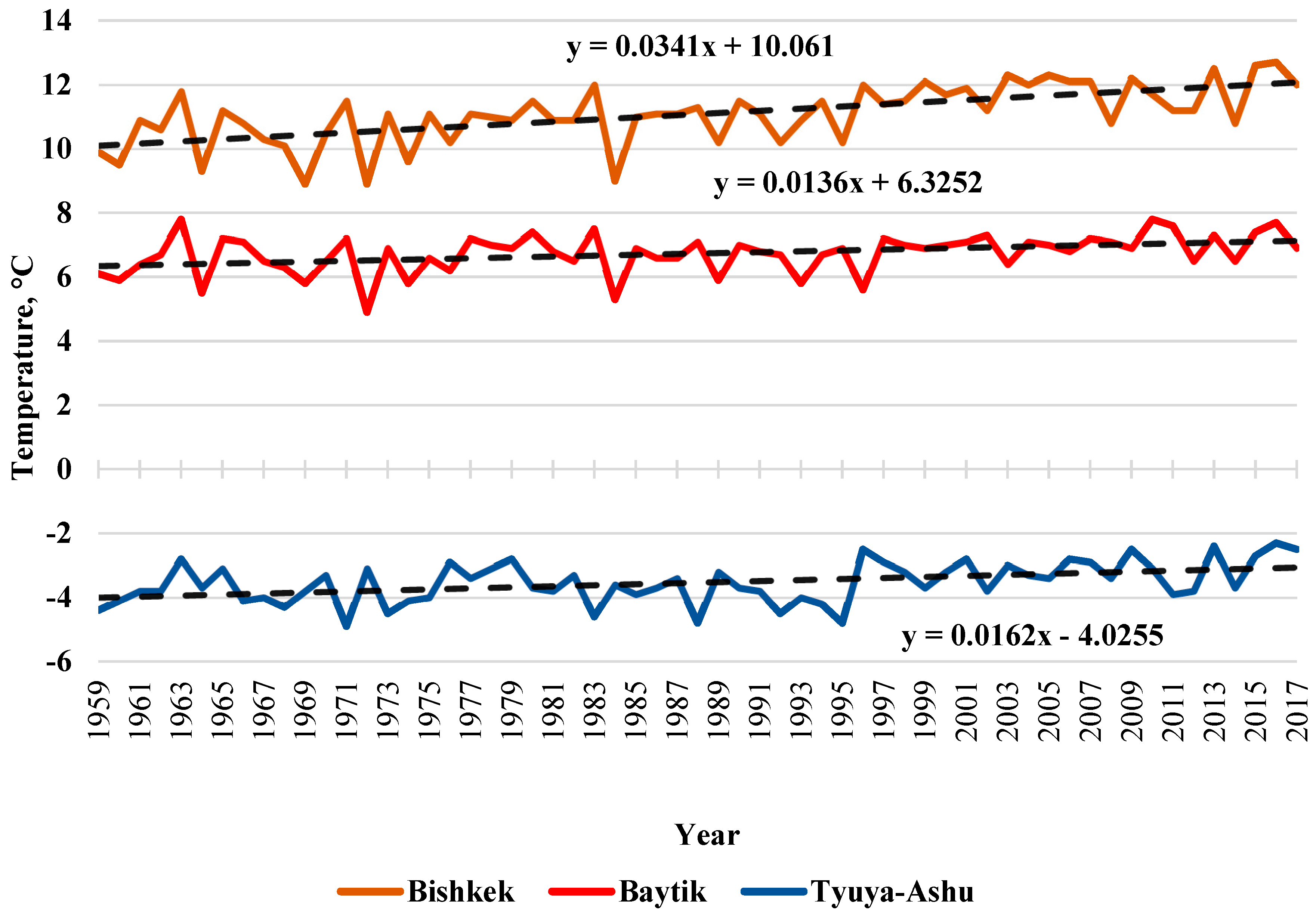
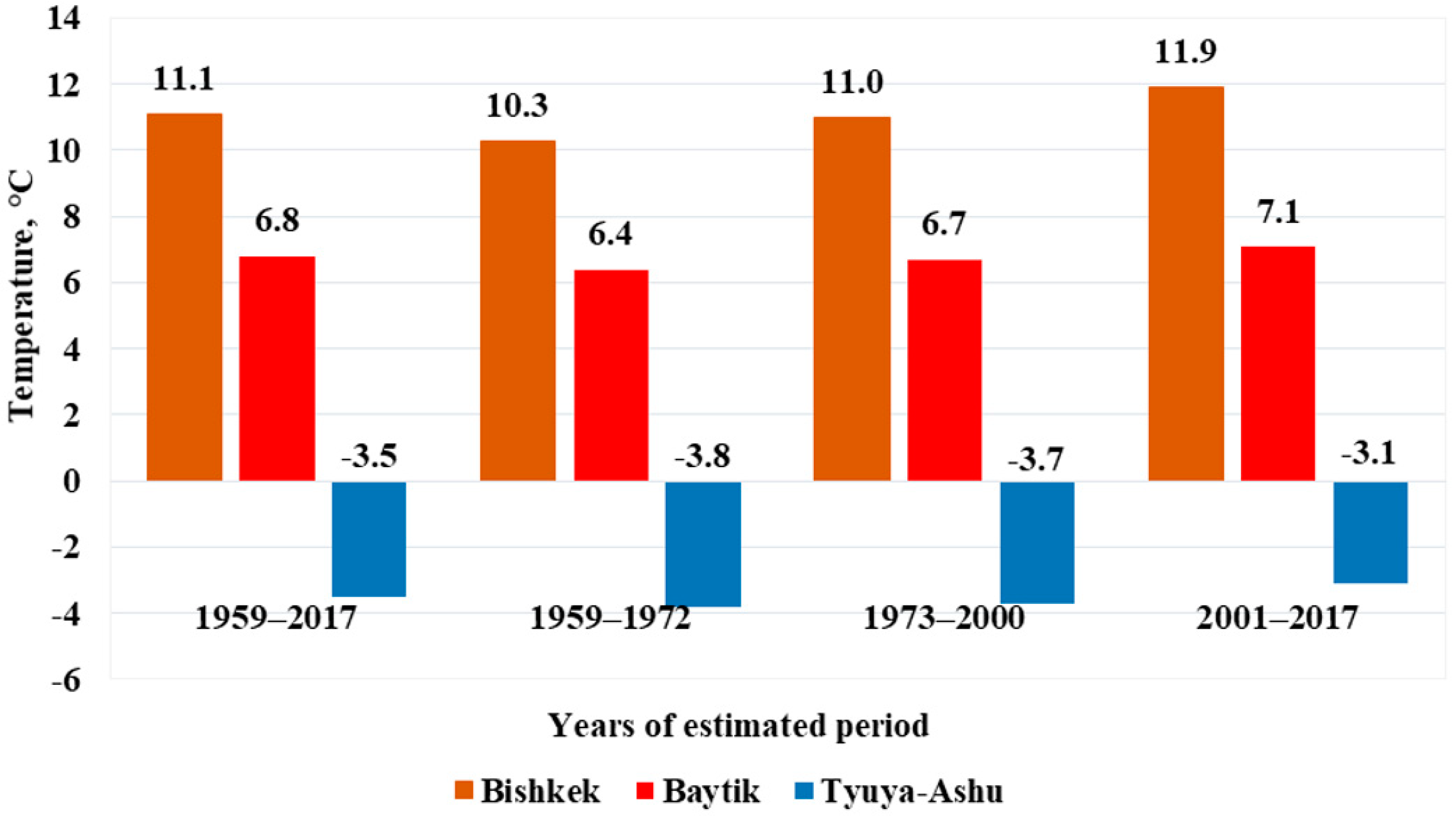
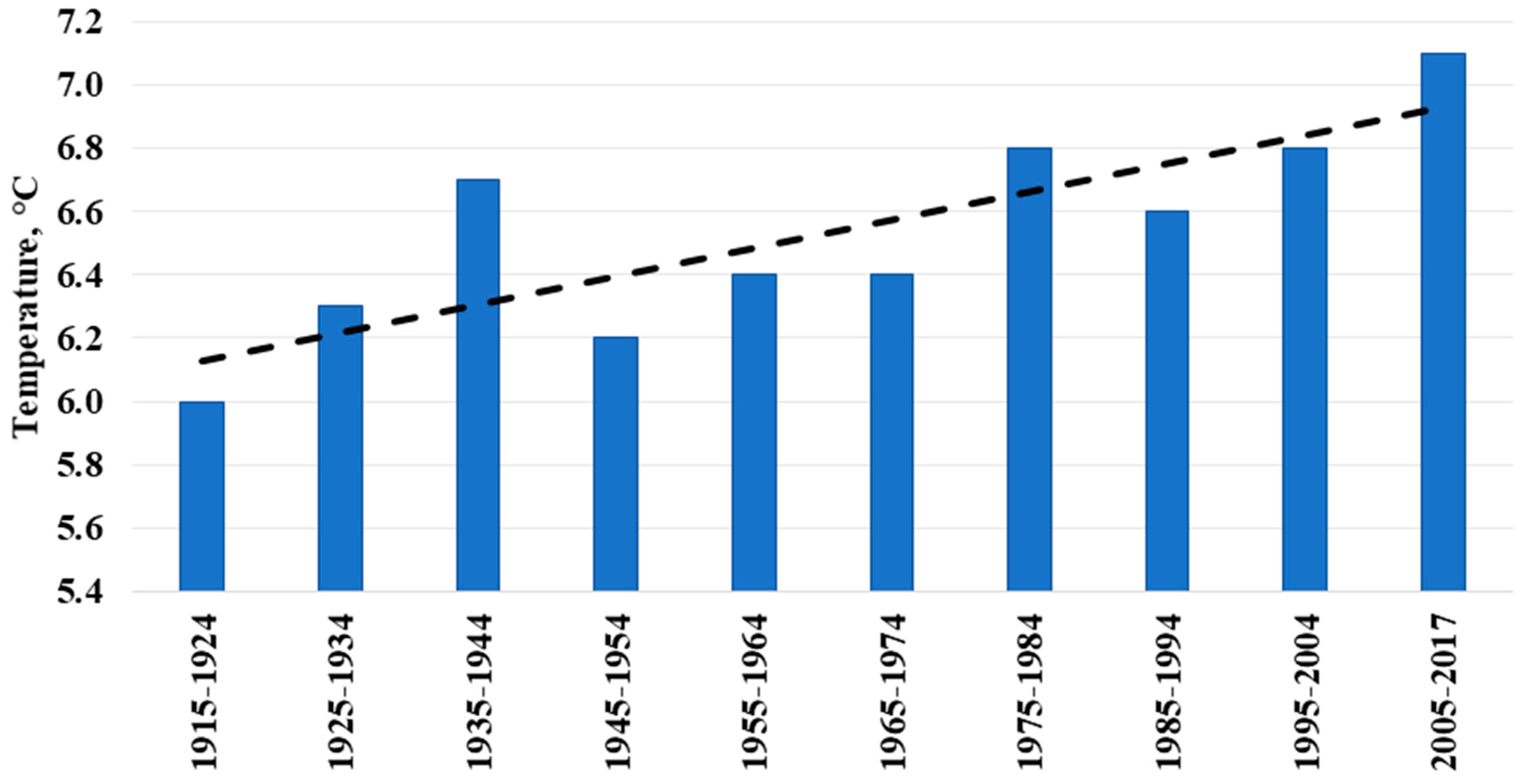
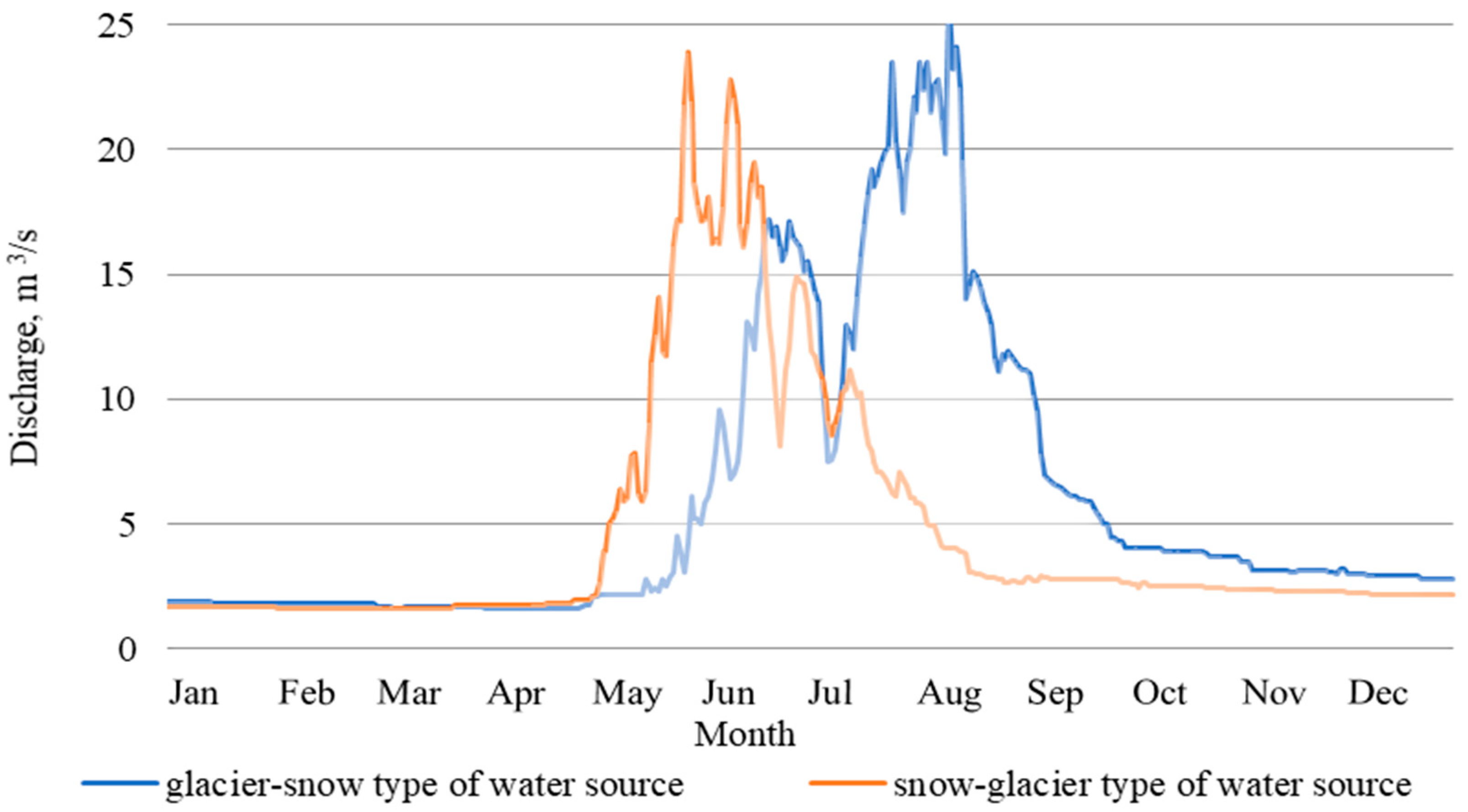
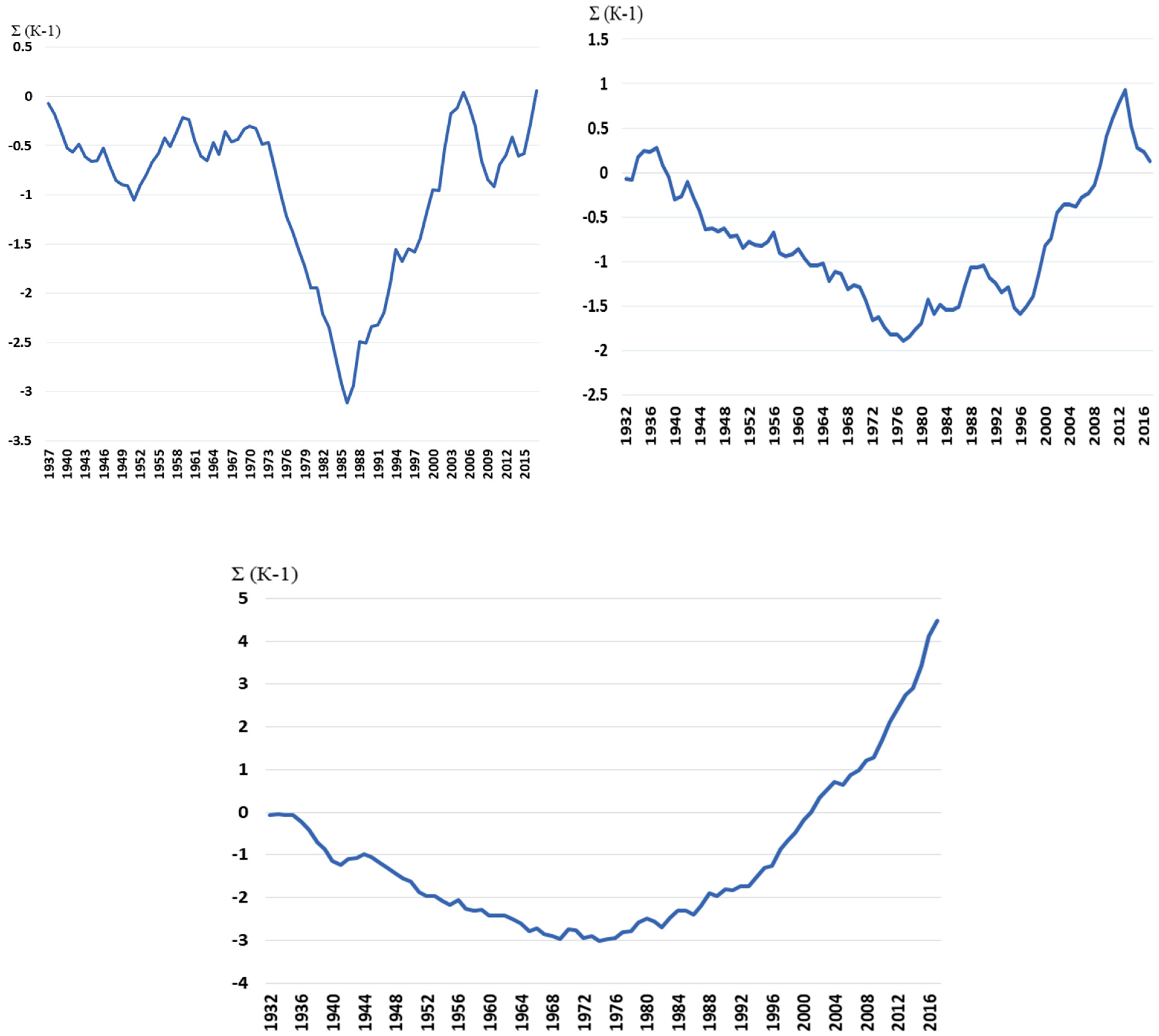
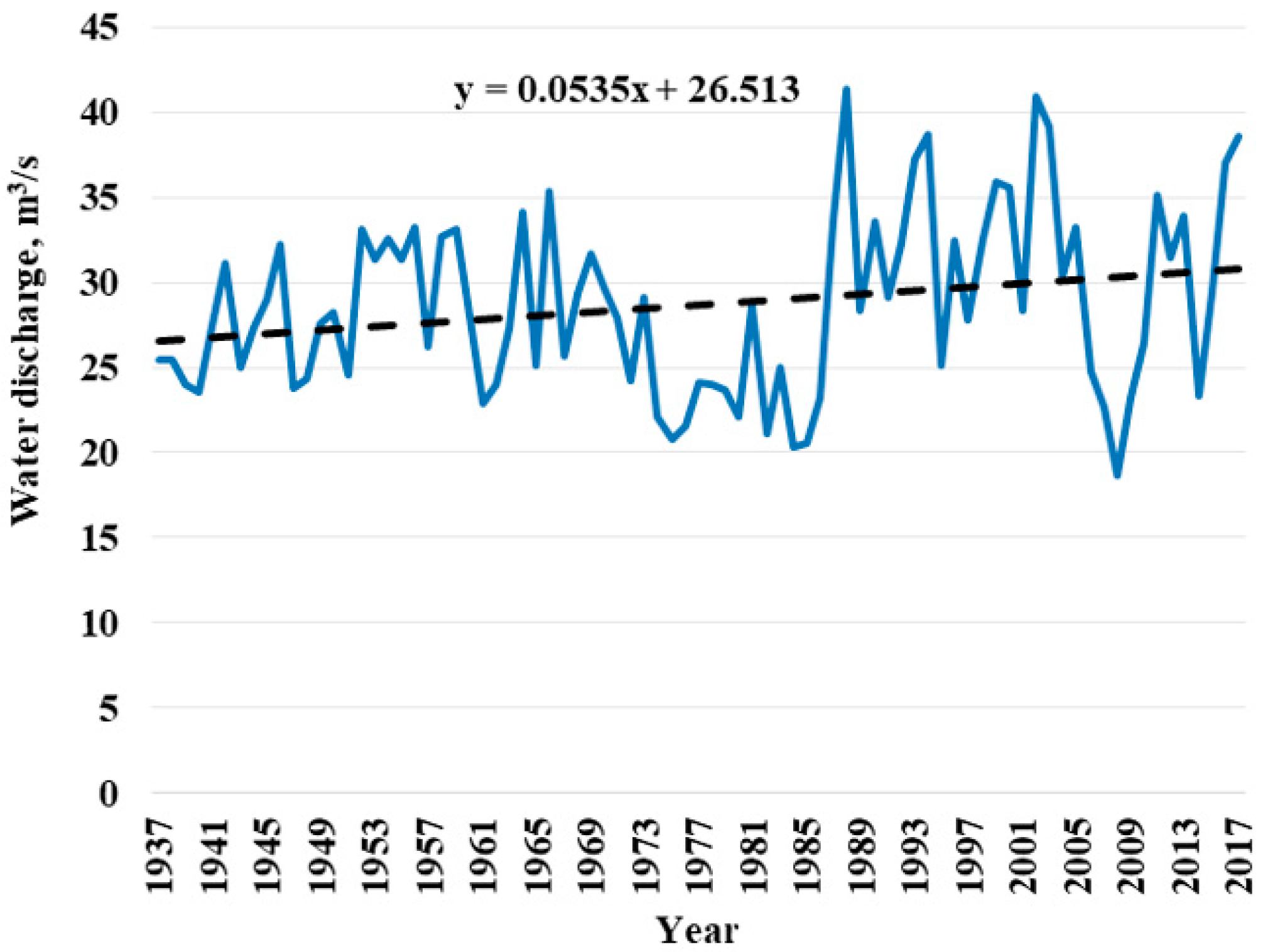
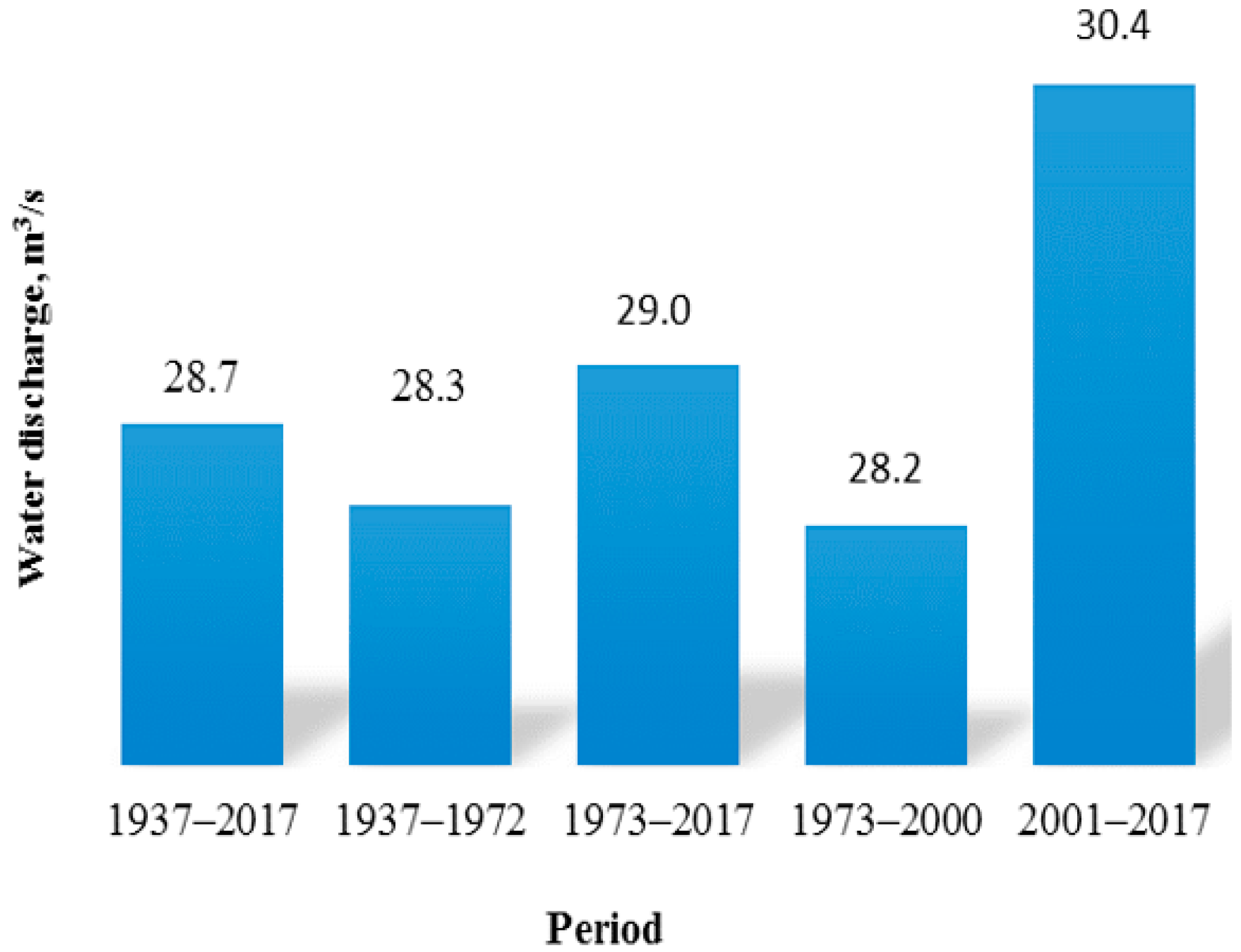
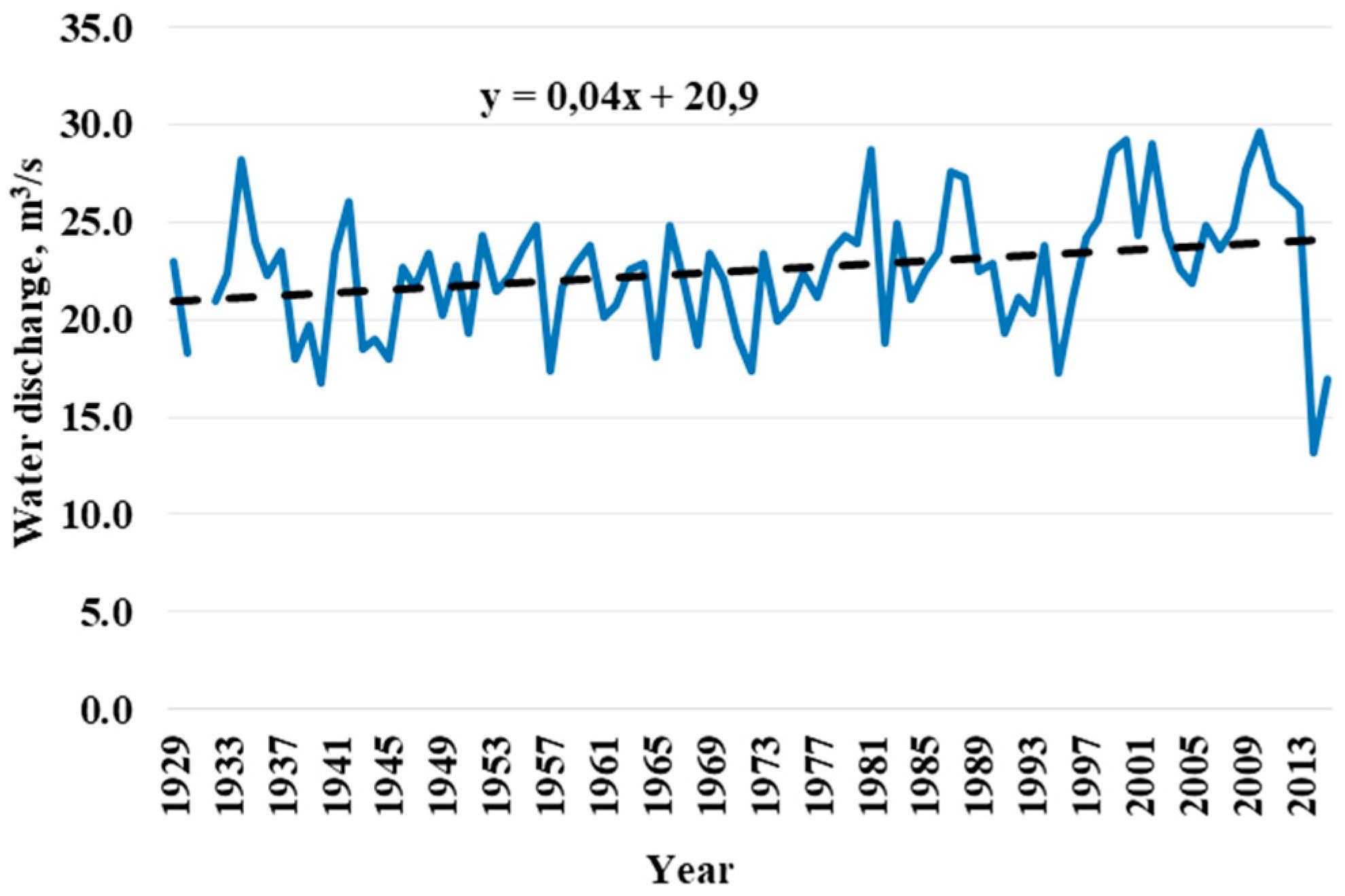
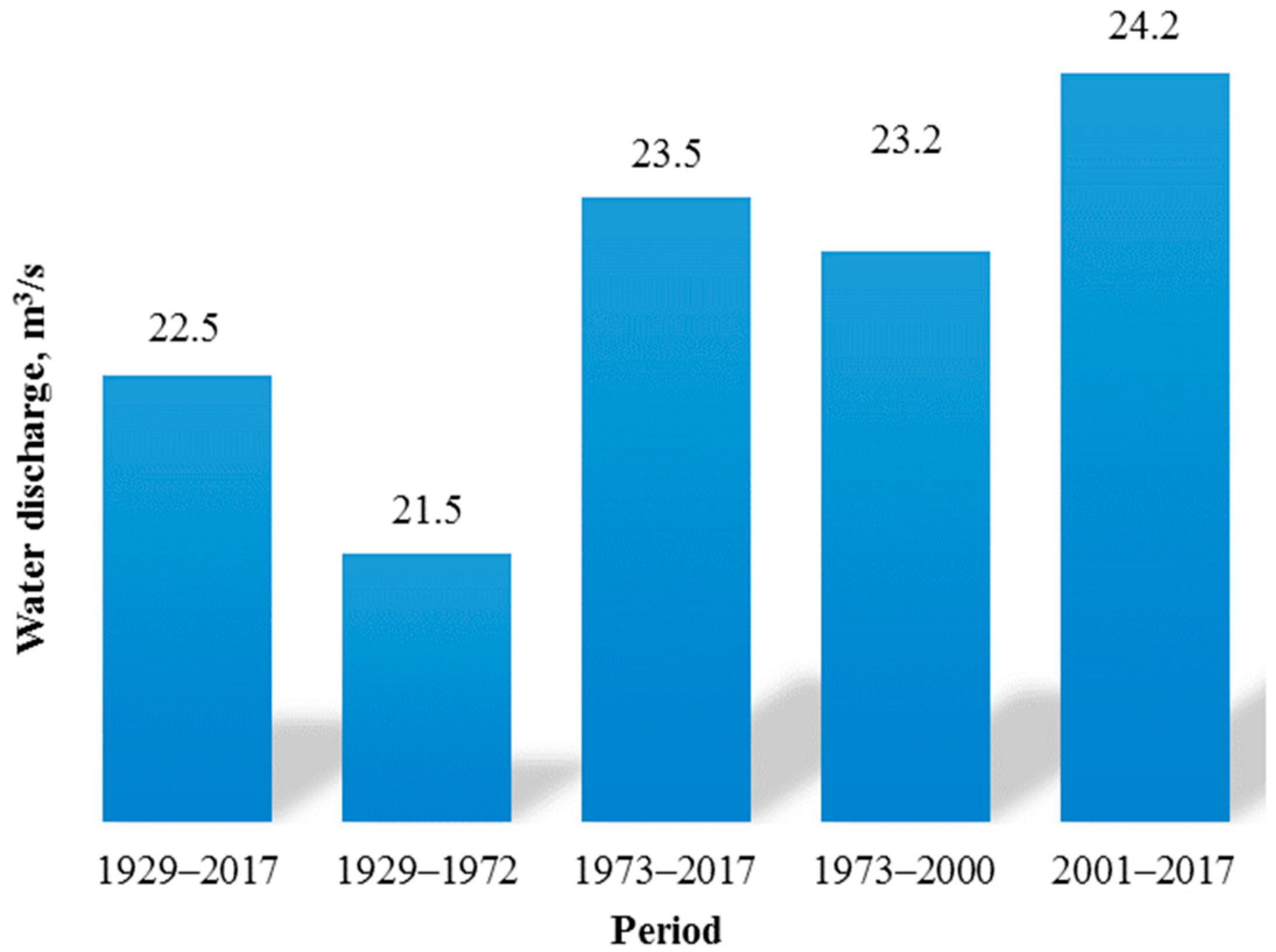
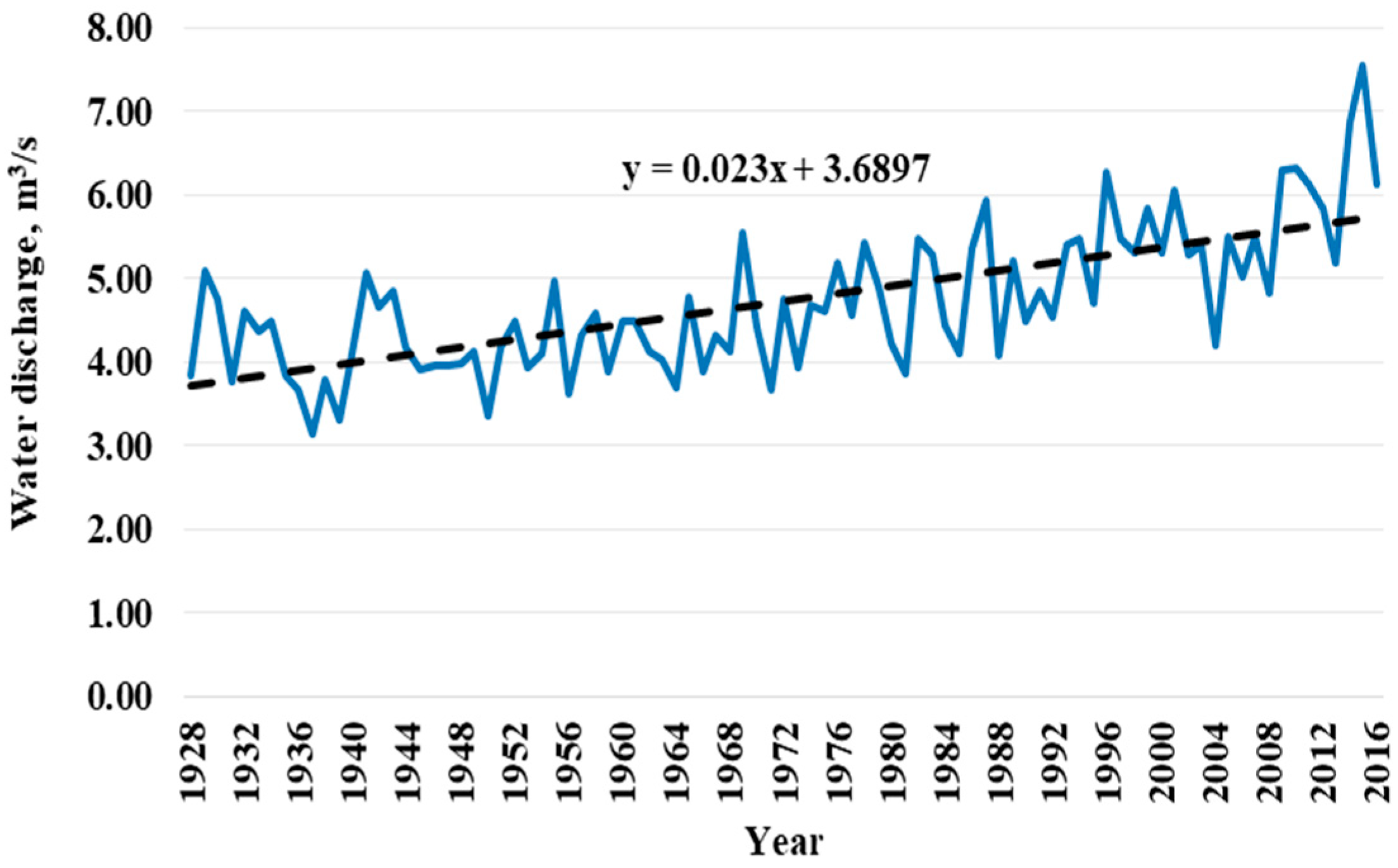
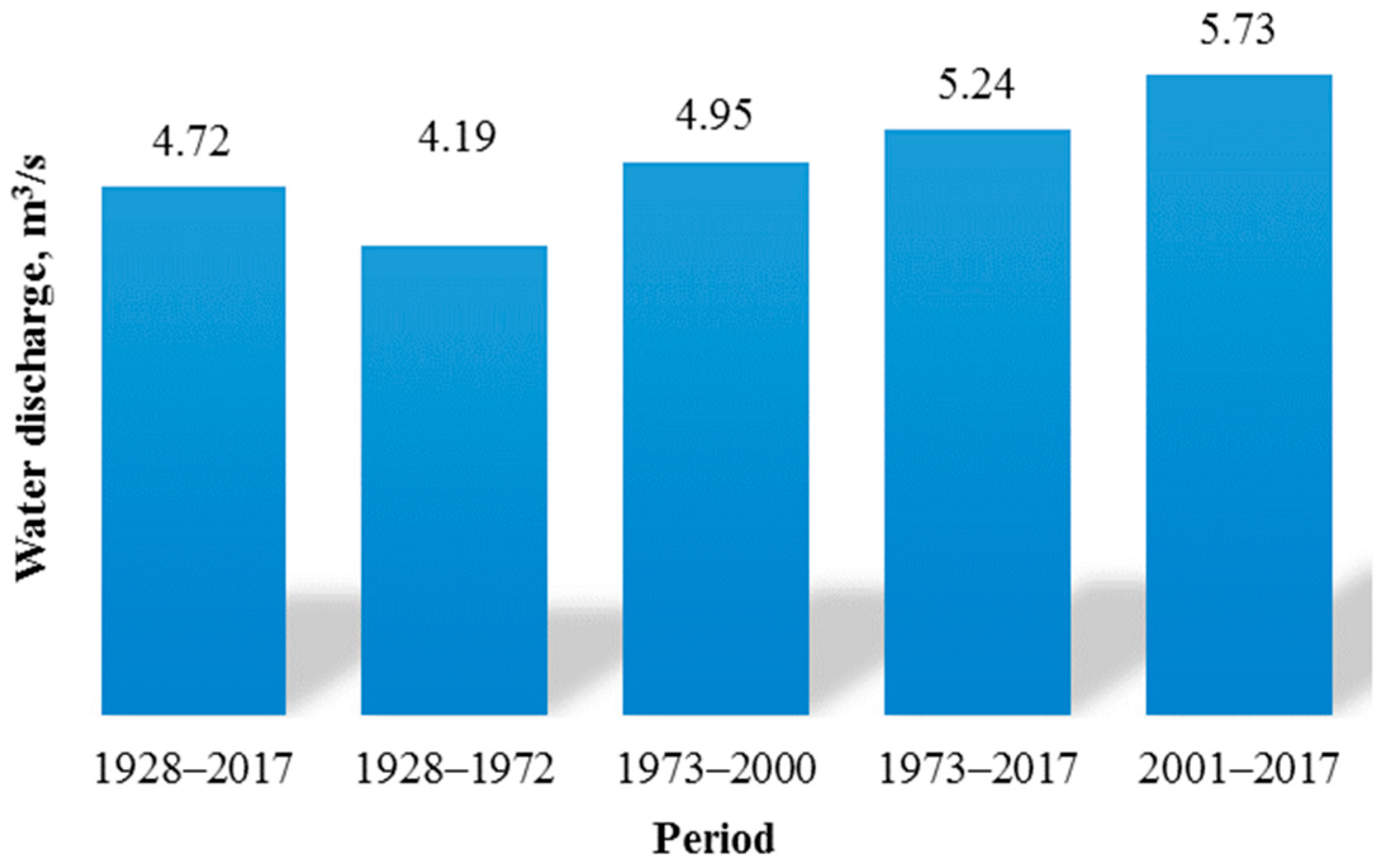
| Weather Station | Elevation m.a.s.l | Zone | Observation Period | |
|---|---|---|---|---|
| 1 | Bishkek | 756 | Plain | 1932–2017 |
| 2 | Baytik | 1579 | Foothill | 1914–2017 |
| 3 | Tyuya-Ashu | 3120 | Alpine | 1959–2017 |
| 4 | Shabdan | 1532 | Foothill | 1936–2017 |
| River and Tributaries | Gauging Station | Catchment Area, km2 | Mean Elevation m.a.s.l. | Channel Slope % | Glacier Coverage % | Indicator δ | Observation Period | |
|---|---|---|---|---|---|---|---|---|
| 1 | Shu | Kochkorka | 5370 | 2840 | 15 | 1.0 | 1.13 | 1937–2017 |
| 2 | Chon-Kemin | Outlet | 1890 | 3010 | 19 | 6.0 | 1.70 | 1932–2017 |
| 3 | Ala-Archa | Outlet | 233 | 3290 | 69 | 17.0 | 2.24 | 1928–2017 |
| Drainage Area, km2 | Mean Elevation, m.a.s.l | Air Temperature, °C | Precipitation, mm | Evaporation, mm | Runoff mm | Specific Discharge, L/s·km2 |
|---|---|---|---|---|---|---|
| 22,300 | 2166 | 2.45 | 552 | 364 | 188 | 5.73 |
| Weather Stations | R Squared | Observations | Standard Error | Intercept | X Variable | F | Significance F | t Stat | p-Value |
|---|---|---|---|---|---|---|---|---|---|
| Bishkek | 0.40 | 59 | 0.72 | 10.06 | 0.03 | 38.2 | ca 0 | 6.18 | ca 0 |
| Baytik | 0.14 | 59 | 0.57 | 6.32 | 0.01 | 9.6 | 0.003 | 3.10 | 0.003 |
| Tyuya–Ashu | 0.19 | 59 | 0.59 | −4.03 | 0.02 | 13.1 | 0.0006 | 3.62 | 0.0006 |
| Weather Station | R Squared | Observations | Standard Error | Intercept | X Variable | F | Significance F | t Stat | p-Value |
|---|---|---|---|---|---|---|---|---|---|
| Baytik | 0.67 | 10 | 0.2 | 6.04 | 0.089 | 16.06 | 0.004 | 4.01 | 0.004 |
| Estimated Period, Years | Weather Station | |||
|---|---|---|---|---|
| Bishkek | Baytik | Shabdan | Tyuya-Ashu (South) | |
| 1932–1972 | 405 | 567 | 434 | 789 |
| 1932–2017 | 429 | 563 | 447 | 793 |
| 1973–2017 | 456 | 560 | 457 | 797 |
| 2001–2017 | 488 | 566 | 447 | 854 |
| Estimated Period, Years | Number of Years | Average T, °C | Difference of T, °C | T Increase Rate °C/annum | Projection 2050 Increase/T °C | |
|---|---|---|---|---|---|---|
| Bishkek WS | ||||||
| 1959–2017 | 59 | 11.1 | ||||
| 1959–1972 | 14 | 10.3 | −0.8 | −0.057 | ||
| 1973–2000 | 28 | 11.0 | 0.7 | 0.025 | ||
| 2001–2017 | 17 | 11.9 | 0.9 | 0.053 | ||
| Projection 2018–2050 | 33 | 13.6 | 1.75 | 13.6 | ||
| Baytik WS | ||||||
| 1959–2017 | 59 | 6.8 | ||||
| 1959–1972 | 14 | 6.4 | −0.4 | −0.029 | ||
| 1973–2000 | 28 | 6.7 | 0.3 | 0.011 | ||
| 2001–2017 | 17 | 7.1 | 0.4 | 0.024 | ||
| Projection 2018–2050 | 33 | 7.9 | 0.8 | 7.9 | ||
| Tyuya-Ashu WS | ||||||
| 1959–2017 | 59 | −3.5 | ||||
| 1959–1972 | 14 | −3.8 | −0.3 | −0.021 | ||
| 1973–2000 | 28 | −3.7 | 0.1 | 0.004 | ||
| 2001–2017 | 17 | −3.1 | 0.6 | 0.035 | ||
| Projection 2018–2050 | 33 | −2.5 | 0.6 | −2.5 | ||
| Gauge | Winter (December-February) | Spring (March-May) | Summer (June-September) | Autumn (October-November) |
|---|---|---|---|---|
| Issyk-Ata–Yuryevka | 12.9 | 12.5 | 49.6 | 25.0 |
| Alamedin–Chunkurchak | 8.0 | 20.2 | 61.3 | 10.5 |
| Alaarcha–Kashkasuu | 7.0 | 22.0 | 58.0 | 13.0 |
| Gauging Station | R Squared | Observations | Standard Error | Intercept | X Variable | F | Significance F | t Stat | p-Value |
|---|---|---|---|---|---|---|---|---|---|
| Shu at Kochkorka | 0.056 | 81 | 5.18 | 26.51 | 0.053 | 4.73 | 0.033 | 2.17 | 0.032 |
| Chon-Kemin | 0.085 | 87 | 3.11 | 20.85 | 0.037 | 7.9 | 0.0061 | 2.81 | 0.006 |
| Ala-Archa | 0.49 | 90 | 0.6 | 3.68 | 0.023 | 86.2 | ca 0 | 9.28 | ca 0 |
| Flow Parameter | Period of Years | Number of Years | Average Discharge m3/s | Difference m3/s | Discharge Increase Rate m3/s/Annual |
|---|---|---|---|---|---|
| The river Shu at Kochkorka | |||||
| LTMAF | 1937–2017 | 81 | 28.7 | ||
| MAF | 1937–1972 | 36 | 28.3 | −0.4 | |
| MAF | 1973–2000 | 28 | 28.2 | −0.5 | −0.018 |
| MAF | 2001–2017 | 17 | 30.4 | 2.2 | 0.129 |
| MAF * | 2018–2050 | 33 | 34.7 | ||
| The river Chon-Kemin (tributary) | |||||
| LTMAF | 1929–2017 | 88 | 22.5 | ||
| MAF | 1929–1972 | 43 | 21.5 | −1.0 | |
| MAF | 1973–2000 | 28 | 23.2 | 1.7 | 0.061 |
| MAF | 2001–2017 | 17 | 24.2 | 1.0 | 0.059 |
| MAF * | 2018–2050 | 33 | 26.2 | ||
| The river Ala-Archa (tributary) | |||||
| LTMAF | 1928–2017 | 90 | 4.72 | ||
| MAF | 1928–1972 | 45 | 4.19 | −0.53 | |
| MAF | 1973–2000 | 28 | 4.95 | 0.76 | 0.027 |
| MAF | 2001–2017 | 17 | 5.73 | 0.78 | 0.046 |
| MAF * | 2018–2050 | 33 | 7.25 | ||
| Parameter | Period of Years | Number of Years | Discharge m3/s |
|---|---|---|---|
| The river Shu | |||
| Projection | 2018–2050 | 33 | 34.7 |
| Decrease in runoff | VII-IX | 35% | 12.1 |
| Corrected projection | 2050 | 22.6 | |
| Discharge probability 95% | 1937–2017 | 81 | 22.6 |
| Discharge probability 99% | 1937–2017 | 81 | 20.5 |
| The river Chon-Kemin (tributary) | |||
| Projection | 2018–2050 | 33 | 26.2 |
| Decrease in runoff | VII-IX | 44% | 11.5 |
| Corrected Projection | 2050 | 14.7 | |
| Discharge probability 95% | 1929–2017 | 88 | 17.6 |
| Discharge probability 99% | 1929–2017 | 88 | 16.1 |
| The river Ala-Archa (tributary) | |||
| Projection | 2018–2050 | 33 | 7.25 |
| Decrease in runoff | VII-IX | 57% | 4.13 |
| Corrected Projection | 2050 | 3.12 | |
| Discharge probability 95% | 1928–2017 | 90 | 3.39 |
| Discharge probability 99% | 1928–2017 | 90 | 3.10 |
Publisher’s Note: MDPI stays neutral with regard to jurisdictional claims in published maps and institutional affiliations. |
© 2021 by the authors. Licensee MDPI, Basel, Switzerland. This article is an open access article distributed under the terms and conditions of the Creative Commons Attribution (CC BY) license (https://creativecommons.org/licenses/by/4.0/).
Share and Cite
Kaliyeva, K.; Punys, P.; Zhaparkulova, Y. The Impact of Climate Change on Hydrological Regime of the Transboundary River Shu Basin (Kazakhstan–Kyrgyzstan): Forecast for 2050. Water 2021, 13, 2800. https://doi.org/10.3390/w13202800
Kaliyeva K, Punys P, Zhaparkulova Y. The Impact of Climate Change on Hydrological Regime of the Transboundary River Shu Basin (Kazakhstan–Kyrgyzstan): Forecast for 2050. Water. 2021; 13(20):2800. https://doi.org/10.3390/w13202800
Chicago/Turabian StyleKaliyeva, Karlygash, Petras Punys, and Yermekul Zhaparkulova. 2021. "The Impact of Climate Change on Hydrological Regime of the Transboundary River Shu Basin (Kazakhstan–Kyrgyzstan): Forecast for 2050" Water 13, no. 20: 2800. https://doi.org/10.3390/w13202800
APA StyleKaliyeva, K., Punys, P., & Zhaparkulova, Y. (2021). The Impact of Climate Change on Hydrological Regime of the Transboundary River Shu Basin (Kazakhstan–Kyrgyzstan): Forecast for 2050. Water, 13(20), 2800. https://doi.org/10.3390/w13202800







